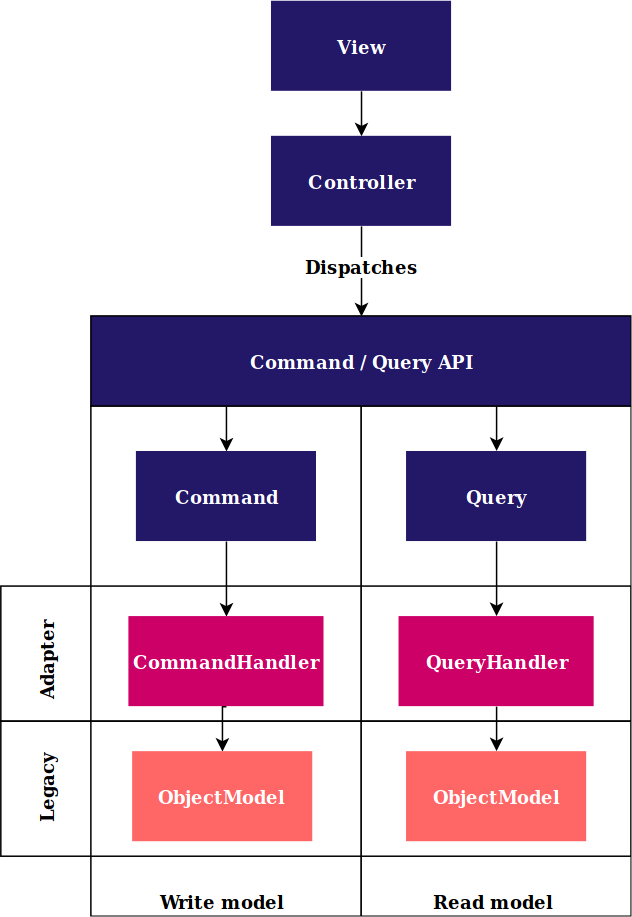Warning: You are browsing the documentation for PrestaShop 1.7, which is outdated.
You might want to read an updated version of this page for the current version, PrestaShop 9. Read the updated version of this page
CQRS - Commands and Queries
What is CQRS?
CQRS stands for Command Query Responsibility Segregation. In brief, the CQRS pattern suggests to separate “write” and “read” models, which it refers to as Commands and Queries. In a web application like a CMS, we perform either “read” operations which return information to the user or “write” operations which modify the data managed by the application.
Why using CQRS in PrestaShop?
During Back Office migration to Symfony, PrestaShop needs a way to access and alter data on the new Symfony pages without multiplying the sources of truth, and without accessing ObjectModel (e.g. Product, Category) directly.
Commands and Queries allow us to isolate the controllers from the data source, which can be later replaced by something else while leaving behind a nice API.
This implementation proposes a “top-down” design, which inverses the classic data-driven design. It starts on a page and the actions performed in it, and then trickles down layer by layer, finishing on the data layer.
Difference between legacy & new architectures
In legacy architecture, controller is calling ObjectModel directly, without providing clear API or separation between read and write model, thus highly coupling data layer with controller. See legacy architecture’s schema below.

Legacy architecture
Fortunately, by implementing CQRS it allows PrestaShop to quickly build new API, but still use legacy ObjectModel by implementing Adapter handlers. This approach enables us to drop ObjectModel and replace it with something else later without breaking new API (Commands & Queries). See new architecture’s schema below:

New architecture using CQRS
CQRS Principles in PrestaShop
- All input validation SHOULD be done during the object construction (see Validation).
- All objects SHOULD be immutable unless it’s impractical to do so.
- The
Core\Domainnamespace describes business objects, actions and messages. It DOES NOT contain behavior (at least for now).
Command and CommandHandler principles
- Any alteration on the state of the application MUST be performed through a
Command. - A
Commanddescribes a single action. It DOES NOT perform it. - A
Commandreceives only primitive types on input (int, float, string, bool and array). - For every
Commandthere MUST be at least oneCommandHandlerwhose role is to execute thatCommand. - A
CommandHandleracts as a port to a Core, therefore it SHOULD NOT handle the domain logic itself, but orchestrate the necessary services instead. - A
CommandHandlerMUST be placed in theAdapternamespace as long as it has legacy dependencies. - A
CommandHandlerSHOULD NOT return anything on success, and SHOULD throw a typedExceptionon failure. The “no return on success” rule can be broken only when creating entities. - A
CommandHandlerMUST implement an interface containing a single public method like this:
<?php
public function handle(NameOfTheCommand $command);
Query and QueryHandler principles
- Data retrieval SHOULD always go through a
Query. - A
Querydescribes a single data query. It DOES NOT perform it. - A
Queryreceives only primitive types on input (int, float, string, bool and array). - For every
Querythere MUST be at least oneQueryHandlerwhose role is to execute thatQueryand return the resulting data set. - A
QueryHandlerSHOULD return a typed object, and SHOULD throw a typedExceptionon failure. - A
QueryHandlerSHOULD use the existingObjectModelfor reads as long as it’s reasonable to do so (in particular for CUD operations in BO migration). - A
QueryHandlerMUST be placed in theAdapternamespace as long as they have legacy dependencies. - A
QueryHandlerSHOULD return data objects that make sense to the domain, and SHOULD NOT leak internal objects. - A
QueryHandlerMUST implement an interface containing a single public method and a typed return like this:
<?php
/**
* @param NameOfTheQuery $query
*
* @return TypeOfReturn
*/
public function handle(NameOfTheQuery $query): TypeOfReturn;
Command and Query buses
Command bus is a pattern used to map Commands and Queries to CommandHandlers and QueryHandlers. PrestaShop defines it’s own CommandBusInterface and implements it using Tactician command bus library.
PrestaShop uses 2 commands buses:
CommandBus- for dispatchingCommandsonlyQueryBus- for dispatchingQueriesonly
CQRS in Debug Toolbar
To help you understand which command/queries are used on a page and how you can interact with them a profiler has been added in the Symfony debug toolbar.

CQRS Debug Toolbar
It shows you a quick resume of the CQRS commands/queries used on the page, you can then have more details in the Symfony profiler page:
